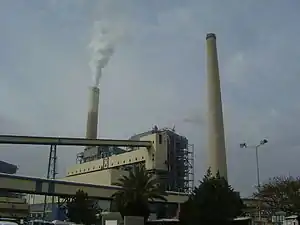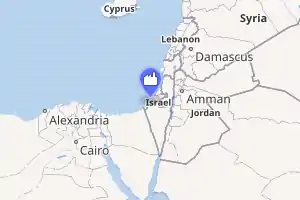Rutenberg Power Station
The Rutenberg Power Station is a coal-powered power plant situated on the Mediterranean coast in Ashkelon, Israel.
| Rutenberg Power Station | |
|---|---|
 | |

| |
| Country | Israel |
| Location | Ashkelon |
| Coordinates | 31°37′39″N 34°30′58″E |
| Status | Operational |
| Commission date | 1990 (block A) 2000 (block B) |
| Owner(s) | Israel Electric Corporation |
| Thermal power station | |
| Primary fuel | Coal |
| Cooling source | Seawater |
| Power generation | |
| Units operational | 2 × 550 MW 2 × 575 MW |
| Make and model | GEC-Alstom (turbines) ABB (turbines) Babcock & Wilcox (boilers) Combustion Engineering (boilers) |
| Nameplate capacity | 2,250 MW |
| External links | |
| Commons | Related media on Commons |
Description
The Rutenberg power station, named for Pinhas Rutenberg, is owned and operated by the Israel Electric Corporation (IEC). Rutenberg is the newest thermal power station in Israel and the second largest in terms of generation capacity. It accounts for about fifteen percent of the IEC's total capacity. The power station is situated close to the sea since its cooling system uses sea water.
Technical data
The power station has a total installed capacity of 2,250 MW. It is arranged in two blocks, each containing two power generating units.[1] Two 550 MW boilers were supplied by Combustion Engineering (ABB) and two 575 MW boilers were supplied by Babcock & Wilcox. Turbines and generators were supplied by GEC-Alstom and ABB.
The power station consumes 18,240 tonnes of coal per day, and 330 tonnes of cooling water per hour.
Pollution control
Block B was constructed with a scrubber (for FGD), while additional pollution control devices were being fitted to the block in 2020. Block A was not originally constructed with an FGD scrubber but one was later retrofitted to it (which also necessitated the construction of a new flue stack). It along with other pollution control devices (including an SCR system for NO
x reduction) became operational in December 2018.[2]
History
Construction began in the early 1980s, after completion of the first phase of the Orot Rabin power station near Hadera. Phase A became operational in 1990. Phase B was finished in 2000. Coal was transported to the station by freight trains from the Port of Ashdod until an on-site deepwater coal pier was completed in 2000.
Cancelled expansion
Phase D expansion consisting of additional coal units at the site was approved in 2008. However, several subsequent objections and the greatly increased availability of domestically-produced natural gas in Israel as an alternative to imported coal starting in the early 2010s led to the plan's cancellation. As a result, 60 dunams of land originally reserved for phase D expansion at the site will be returned by the IEC to the State of Israel in 2020. If built, Phase D would have increased plant generation capacity by an additional 1,250 MW.
References
| Wikimedia Commons has media related to Rutenberg Power Station. |